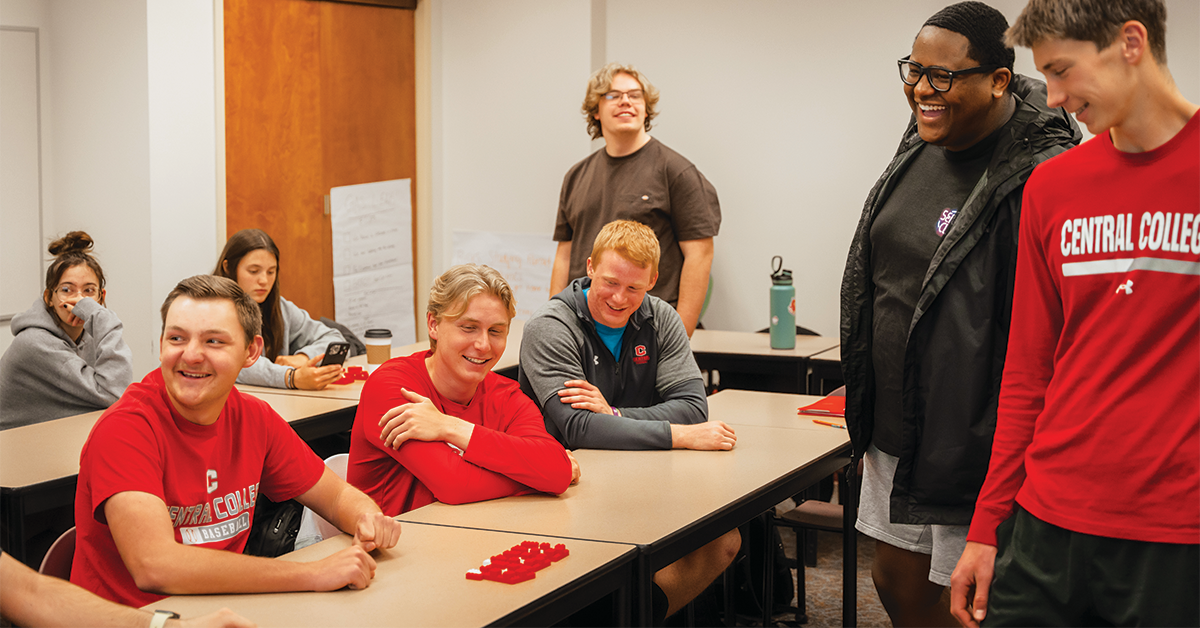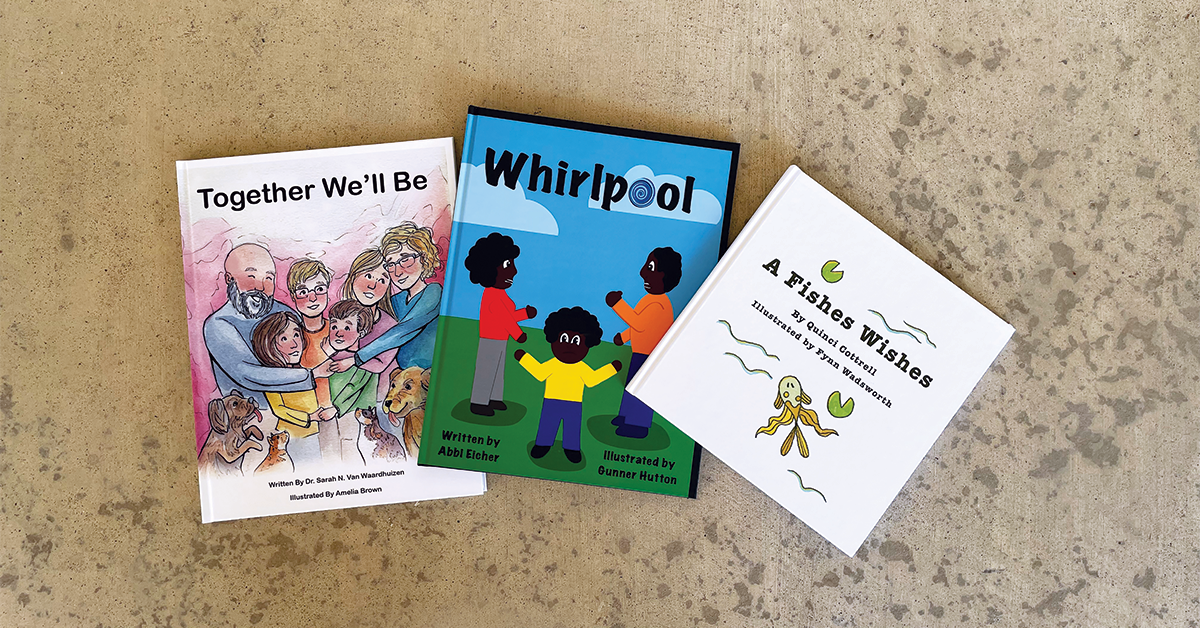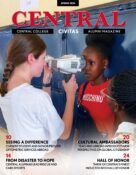
Students in Principles of Microeconomics with Tuan Nguyen, assistant professor of economics, demonstrated the concept of diminishing marginal product of labor through a LEGO® activity in Spring 2023
A Central College education goes beyond lectures, memorization and exams. Students enter classrooms with open minds, and graduates begin careers with a practical understanding of their field. Experiential learning can be observed campus-wide due to the dedication of professors who enter their classrooms each day prepared to create valuable learning experiences for students. Central faculty are more than mentors: They’re lifelong students.
Maggie Fisher Schlerman ’02, associate professor of accounting, models Central’s aptitude to explore new methods of teaching. Her work has established a foundation for other faculty members to build upon.
The Missing Piece
Schlerman collaborated with members of the Economics/Accounting/Management Department, including Crystal Bruntz, lecturer of accounting; Graham Lemke, Donald T. Butler Endowed Chair and professor of finance; Tuan Nguyen, assistant professor of economics; George Nwaogu, associate professor of economics; and Julie Summers, lecturer of management and marketing. These faculty created activities to demonstrate business concepts using LEGO® blocks.
It started with a need for a hands-on activity for prospective students visiting during group visit days. Campus visits are the perfect moment for interactive activities that show prospective students what learning looks like in Central’s classrooms, and how theories can go beyond lectures.
“It’s hard to get a good discussion going if students don’t know the other students at the table,” Schlerman says. “If you can give students a shared common task, that’s one way to build trust. It’s a nice hands-on activity that can be a conversation starter.”
After a successful kickoff of the experiment at a visit day, Schlerman’s LEGO idea grew. She brought her idea to her colleagues, and EAM faculty members began determining activities that could demonstrate theories while providing a collaborative and competitive experience for students.
It Just Clicks
As their ideas expanded, the need for additional equipment grew with it. The Moore Family Foundation funded a custom order from LEGO, obtaining new blocks in the right sizes and the right colors (red and white, of course). Blocks in hand, the faculty members met over the summer to start trying new experiments.
“It did take some trial and error,” Schlerman admits. “Sometimes you have to find people who haven’t done the activity before. I’ve even tried it out on my family!”
Because of the variety of audiences, faculty members must be prepared to adapt their experiments based on who’s involved.
“Part of the reason why the activity goes so well now is because we anticipated a lot of potential problems with the experiment,” Nguyen adds. “We’ve tweaked it to the point where we anticipate that any problems would be minimal.”
Nguyen’s LEGO activity is now an established piece of his Principles of Microeconomics class to demonstrate diminishing marginal product of labor. The activity is now a highlight for students in his class, and he sees a stronger understanding of the concept.
“Part of my job is to balance how much theoretical exposure they have before the activity and how that corresponds to the level of rigor I do for these experiments,” Nguyen says. “Economics can be a very theoretical field. A lot of the time, we tell students what could potentially happen, but they don’t get to verify it. But if you learn something and you get to observe that it really works, it resonates with you more.”
The feedback from students affirms the change in material presentation. Not only are they learning about core concepts in their class, but they’re excited about how they’re learning.
“I think it’s helpful to break up the monotony of a lecture. Students like it because it gives them a different aspect of exposure to the material,” Nguyen explains.
Build It Yourself
Schlerman and Nguyen aren’t the only professors bringing LEGO bricks to their classrooms. Most EAM faculty members use the LEGO as learning tools.
“As students progress through their business management degree, they get bits and pieces of this activity that interconnect classes together,” Nguyen says. “It gives them an idea about how they can take a concept, see it in action and apply it to the real world.”
The foundation these professors have built continues to bridge opportunities throughout students’ education. Schlerman, Nguyen, Bruntz, Lemke, Nwaogu and Summers led an interactive presentation at Central’s Endowed Chairs’ Conference in Fall 2022, inviting Central faculty to use LEGO bricks in classrooms across campus.
“Learning science points to the fact that students will remember this better when they’re using their muscle memory and they’re more actively engaged with the content this way,” Schlerman says. “Activities like these are likely to support students learning complicated theories and support learning that will benefit students beyond an exam.”

Sarah Van Waardhuizen, associate professor of music, and Amelia Brown ’25 present their original children’s book, “Together We’ll Be” at the Undergraduate Research presentations.
A High Note
Hands-on learning can go beyond classroom activities and extend into a masterpiece. Sarah Van Waardhuizen, associate professor of music, leads a creative approach to music education. In Elementary Music Methods, Van Waardhuizen asks students to create a children’s book, complete with an original story, a song and illustrations.
“Children’s books are usually very rhythmic and pattern based. That’s music. It organically works very well together,” Van Waardhuizen says. “What many children’s books are missing is an actual song. I always just make one up and sing it. For years now, I thought, if I ever write a children’s book, it has to have music.”
Now, in the context of this course, Van Waardhuizen has found a reason to create a children’s book her way.
This isn’t the first time Van Waardhuizen is teaching this class, but it is a new approach. “Students want relevancy,” Van Waardhuizen says. “They can Google and find a lot of information. In my classes, I’m trying to create assignments that are not Googleable.”
While students still learn about crucial moments in history, it’s presented differently. Van Waardhuizen condenses lectures so the class focus can be on creativity and innovation.
Van Waardhuizen launched her idea in Spring 2023 with two future music educators. The course is designed for music education majors, and Van Waardhuizen tasked those students with creating a children’s book complete with a moral and an original song. The remaining step was illustrating each book. With support from Mat Kelly, professor of art, Van Waardhuizen connected with three artists who could help.
“Each student has their own book and their own artist that they collaborated with,” Van Waardhuizen explains. “They had to meet with them and discuss how they wanted to portray things. The artists had a lot of liberty as well.”

Students in Elementary Music Methods wrote and illustrated original children’s books. These stories are written by Sarah Van Waardhuizen, associate professor of music, Abbi Eicher ’24 and Quinci Cottrell ’24. Amelia Brown ’25, Gunner Hutton ’25 and Fynn Wadsworth ’25 illustrated.
Written By …
Van Waardhuizen knew that for the first iteration of this project, it was important for her to participate. She completed homework, collaborated with an artist and created a book along with her class. Her involvement helps her understand how to better instruct students and adapt the project to improve the learning process and final results.
“All of our creative processes have been different, and yet, we came to the same conclusion,” Van Waardhuizen says. “I study autonomy and supportive teaching and learning. Part of that is having autonomy to be creative. I didn’t want to stifle that. I do have some parameters, but I tried to give some leeway.”
This project creates a creative opportunity to help Van Waardhuizen approach her work feeling refreshed.
“Sometimes in your job or when working creatively, you need rejuvenation,” Van Waardhuizen says. “This project has given that to me. It’s been really fun personally, and I love seeing the students get excited about it.”
Encore
The partnership between music educators and artists created a beautiful opportunity for students to learn about different mediums of storytelling.
“The collaboration process between the art program and music program has been really exciting to see come to fruition,” Van Waardhuizen says. “I want my students to feel empowered that they can create and make a difference with their words.”
It’s opened the door for similar partnerships across campus. From communication studies majors to psychology students, Van Waardhuizen knows there are a number of faculty who would be interested in participating.
Trust between student and professor makes projects like these possible. Van Waardhuizen is thankful that she had the opportunity to try something new and produce a story meaningful to her.
“Sometimes if you have an idea, you just have to throw it out there, see what happens and then pick up the pieces for the next time. I feel like we’ve done that,” Van Waardhuizen says. “And the students went along with it, which is so fun.”
You can purchase copies of the children’s books written and illustrated by Central students at lulu.com.
Artwork By: Melody Vanderleest
Photos By: Dustin Dawson and Kayla Lindquist ’25












To encourage serious, intellectual discourse on Civitas, please include your first and last name when commenting. Anonymous comments will be removed.
Comments are closed.